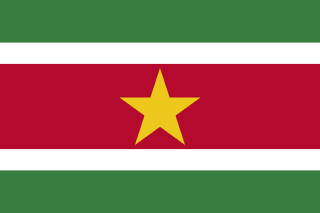Suriname - Geography

Here, let us take a look at the Geography of Suriname. Smallest independent country on the South American continent; mostly tropical rainforest; great diversity of flora and fauna; relatively small population, mostly along the coast. Mother's mean age at first birth is (), whereas, the Maternal mortality ratio is 84 deaths/100,000 live births (2023 est.)
Geographical data of Suriname
| Location | Northern South America, bordering the North Atlantic Ocean, between French Guiana and Guyana |
|---|---|
| Geographic coordinates | 4 00 N, 56 00 W |
| Map references | South America |
| Tarrain | mostly rolling hills; narrow coastal plain with swamps |
| Natural Resources | timber, hydropower, fish, kaolin, shrimp, bauxite, gold, and small amounts of nickel, copper, platinum, iron ore |
| Natural Hazards | flooding |
| Irrigated Land | 600 sq km (2020) |
| Major rivers (by length in km) | |
| Major aquifers | |
| Land Boundaries | 1,907 km |
| Border Countries | Brazil 515 km; French Guiana 556 km; Guyana 836 km |
| Coastline | 386 km |
| Climate | tropical; moderated by trade winds |
| Area | |
| Total Area | |
| Land Area | 156,000 sq km |
| Water Area | 7,820 sq km |
| comparative Area | slightly larger than Georgia |
| Maritime Claims | |
| Territorial sea | 12 nm |
| Exclusive economic zone | 200 nm |
| Elevations | |
| Highest point | Juliana Top 1,230 m |
| Lowest point | unnamed location in the coastal plain -2 m |
| Mean elevation | 246 m |
| Land Use | |
| Agricultural land | 0.4% (2023 est.) |
| Agricultural land: arable land | arable land: 0.3% (2023 est.) |
| Agricultural land: permanent crops | permanent crops: 0% (2023 est.) |
| Agricultural land: permanent pasture | permanent pasture: 0.1% (2023 est.) |
| Forest | 91.7% (2023 est.) |
| Other | 7.9% (2023 est.) |
Population Distribution
Population is concentrated along the northern coastal strip; the remainder of the country is sparsely populated
People and Society
In Suriname, the different Ethnic groups are such that we have: Hindustani (also known locally as "East Indians"; their ancestors emigrated from northern India in the latter part of the 19th century) 27.4%, Maroon (their African ancestors were brought to the country in the 17th and 18th centuries as slaves and escaped to the interior) 21.7%, Creole (mixed White and Black) 15.7%, Javanese 13.7%, mixed 13.4%, other 7.6%, unspecified 0.6% (2012 est.)
| Population | |
|---|---|
| Pop growth rate | 1.07% (2024 est.) |
| Birth rate | 14.9 births/1,000 population (2024 est.) |
| Death rate | 6.7 deaths/1,000 population (2024 est.) |
| Health expenditure | |
| Physicians Density | |
| Hospital bed Density | 2.9 beds/1,000 population (2020 est.) |
| Total fertility rate | 1.89 children born/woman (2024 est.) |
| Gross reproduction rate | 0.91 (2024 est.) |
| Contraceptive prevalence rate | |
| Est married women (ages 15-49) | 52.1% (2023 est.) |
| Literacy | |
| Education expenditures | |
| Net Migration rate | 2.5 migrant(s)/1,000 population (2024 est.) |
| Nationality | Surinamese | Surinamer(s) |
| Languages | |
| Religions | Protestant 23.6% (includes Evangelical 11.2%, Moravian 11.2%, Reformed 0.7%, Lutheran 0.5%), Hindu 22.3%, Roman Catholic 21.6%, Muslim 13.8%, other Christian 3.2%, Winti 1.8%, Jehovah's Witness 1.2%, other 1.7%, none 7.5%, unspecified 3.2% (2012 est.) |
| Age Structure | |
| 0-14 years | 22.5% (male 73,864/female 71,573) |
| 15-64 years | 70% (male 226,417/female 226,235) |
| 65 years and over | 7.5% (2024 est.) (male 20,071/female 28,598) |
| Dependency Ratios | |
| Total dependency ratio | 42.9 (2024 est.) |
| Youth dependency ratio | 32.1 (2024 est.) |
| Elderly dependency ratio | 10.8 (2024 est.) |
| Potential support ratio | 9.3 (2024 est.) |
| Median Age | |
| Total | 32 years (2024 est.) |
| Male | 31 years |
| Female | 32.9 years |
| Urbanization | |
| Urban population | 66.4% of total population (2023) |
| Rate of urbanization | 0.88% annual rate of change (2020-25 est.) |
| Major urban areas (Pop) | 239,000 PARAMARIBO (capital) (2018). |
| Sex Ratio | |
| At birth | 1.07 male(s)/female |
| 0-14 years | 1.03 male(s)/female |
| 15-64 years | 1 male(s)/female |
| 65 years and over | 0.7 male(s)/female |
| Total population | 0.98 male(s)/female (2024 est.) |
| Infant Motality | |
| Total | 29.6 deaths/1,000 live births (2024 est.) |
| Male | 37.6 deaths/1,000 live births |
| Female | 21 deaths/1,000 live births |
| Life Expectancy at birth | |
| Total population | 72.7 years (2024 est.) |
| Male | 69 years |
| Female | 76.7 years |
| Drinking Water Sources | |
| Improved: urban | urban: 98.7% of population (2022 est.) |
| Improved: rural | rural: 96.6% of population (2022 est.) |
| Improved: total | total: 98% of population (2022 est.) |
| Unimproved: urban | urban: 1.3% of population (2022 est.) |
| Unimproved: rural | rural: 3.4% of population (2022 est.) |
| Unimproved: total | total: 2% of population (2022 est.) |
| Sanitation facility acess | |
| Improved: urban | urban: 98.5% of population (2022 est.) |
| Improved: rural | rural: 91.2% of population (2022 est.) |
| Improved: total | total: 96.1% of population (2022 est.) |
| Unimproved: urban | urban: 1.5% of population (2022 est.) |
| Unimproved: rural | rural: 8.8% of population (2022 est.) |
| Unimproved: total | total: 3.9% of population (2022 est.) |
| Alcohol consumption per capita | |
| Total | 6.6 liters of pure alcohol (2019 est.) |
| Beer | 3.4 liters of pure alcohol (2019 est.) |
| Wine | 0.14 liters of pure alcohol (2019 est.) |
| Spirits | 2.87 liters of pure alcohol (2019 est.) |
| Other alcohols | 0.18 liters of pure alcohol (2019 est.) |
| Child marriage | |
| Women married by age 15 | 8.8% (2018) |
| Women married by age 18 | 36% (2018) |
| Men married by age 18 | 19.6% (2018) |
Demographic profile
All Important Facts about Suriname
Want to know more about Suriname? Check all different factbooks for Suriname below.









